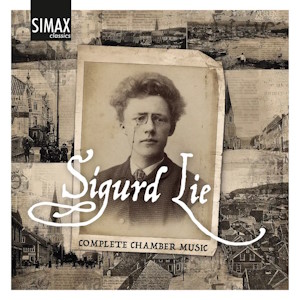
Sigurd Lie (1871-1904)
Complete Chamber Music
rec. 2023, Kilden, Kristiansand, Norway
Simax Classics PSC1410 [77]
Sigurd Lie is, as far as I know, a fairly unknown name outside Norway, and even there he has been a nonperson to the general public until quite recently. The reason was very simple: his output was rather limited, and it remained mainly unpublished. He was also so heavily in demand as musician in various capacities during most of his life and had little time for composing. This anonymity has however been partly rectified during the last few years, when some of his works have been recorded, including his unfinished symphony and his complete songs. His life was also darkened by illness. It seems that the first signs of tuberculosis showed at the early age of nineteen, eventually leading to his demise at only thirty-three. However, he was a talented musician, learnt early to play the piano and the violin, and when twenty years old went to Leipzig, where he studied composition with Carl Reinecke for two years. Some of the earliest fruits of his studies were the string quartet and the piano quintet, which constitute the backbone of the present disc with his complete chamber music, here recorded for the first time.
His string quartet is dated Leipzig 1893, and the piano quintet, which obviously is his magnum opus, is dated Leipzig 1893 – 1894. It was probably not completely finished until he returned to Norway, and it was premiered on 10 March 1894 at an examination concert for students in Leipzig. Lie returned to Germany particularly to play the piano part at this occasion, and both the playing and the composition got excellent reviews. The work was performed in Norway on several occasions during the following ten years, and even as late as at the centennial celebration of the Norwegian Constitution in 1914 in Stavanger and Kristiania, which was the name of the capital at that time. But after that the music was lost, and was not discovered until 2020. What was found then was a copy in another hand, and nobody knows whether the original manuscript still exists somewhere. After listening to the work in the admirable first recording in this album, I am convinced that this is a valuable addition to the Norwegian chamber music repertoire.
After a slow introduction, marked Andante sostenuto, somewhat hesitant, almost sighing, the piano presents the bold and enthusiastic main theme of the Allegro con brio first movement, repeated by the strings with similar optimism. It is also the strings that, after some lingering, introduces the secondary theme, a singable, slightly melancholy melody that, in spite of its relative mildness, refuses to be subordinate to the main theme in the development section. There is a stimulating freshness in the interplay between the two themes, which concludes in a jubilant finale.
The scherzo is also bubbling with vitality, and has a folk-music-inspired, contrasting second theme of charming simplicity. After these two movements filled with activity, the Andante cantabile, a very beautiful folk song comes as a soothing resting-point before the light and playful Molto vivace finale brings the quintet to a joyous conclusion. It should be mentioned that the third and fourth movements are self-borrowings from the string quartet, which, in hindsight, stands out as an apprentice work, whereas the quintet is the masterpiece.
That doesn’t necessarily mean that it has no merits. On the contrary it is a charming, basically light-hearted composition, and the folk music inspiration is even more outspoken than in the quintet. The first movement, Allegro non troppo, is youthfully enthusiastic, more lyrical than the corresponding movement in the quintet. The slow movement is certainly the gem in both compositions. In the quintet version it has been amended with an introduction of ten measures and been transposed, but both versions are equally beautiful, and I have with pleasure returned to both alternately. The third movement is even more folksy with a springy and down-to-earth rural dance, and then the quartet is rounded off with a light and bouncy finale, marked Allegro con fuoco, truly vigorous.
The “fillers” for violin and piano are no vapid ditties, but substantial, albeit brief, character pieces. The two Norwegian dances further enhance the Scandinavian melos and rhythms. Both Jonas Båtstrand and Jørn Fossheim (the latter is also producer and editor and also author of the substantial and well-written liner notes) have a deep interest in Norwegian music, and guarantee that these readings have a stamp of authenticity. The remaining pieces have a more general touch. Romance is sweet in a Kreislerian style, Alfedans (Elfin dance) is airy and mysterious, like something from a Midsummer Night’s Deram, the Humoresque is a virtuoso dance, and Moderens Vuggesang (The Mother’s Cradle Song) was originally a song with lyrics by Vilhelm Krag from 1895, which became very popular, and Lie quickly made a transcription for violin and piano. It is simple and melodious, perfect to lull a baby to sleep.
This is a delicious programme, excellently played, that should win Sigurd Lie a host of new admirers.
Göran Forsling
Buying this recording via a link below generates revenue for MWI, which helps the site remain free


Contents
1 – 4. Piano Quintet [26:25]
5 – 8. String Quartet [28:03]
9 – 10. 2 Norwegian Dances [8:08]
11. Romance [5:14]
12. Alfedans – Elfin dance [2:46]
13. Humoresque [4:36]
14. Moderens Vuggesang – The Mother’s Cradle Song [2:10]
Artists:
Jørn Fossheim (piano) (1 – 4, 9 – 14], Jonas Båtstrand (violin) (1 – 14), Lars Lunde (violin) (1 – 8), Kjell Åge Stoveland (viola) (1 – 8), Ariel de Wolf (cello) (1 – 8)

















